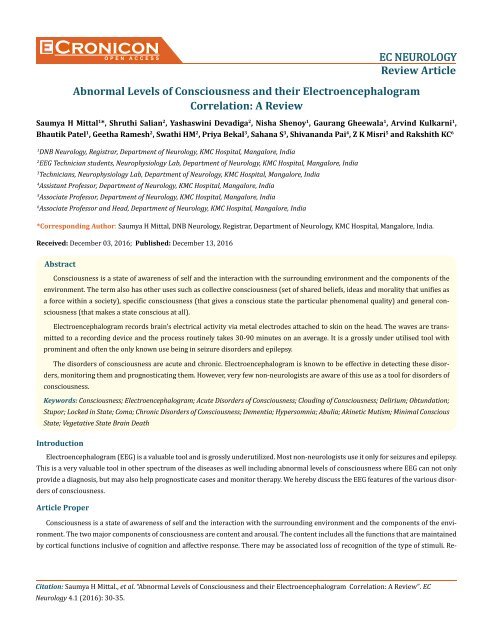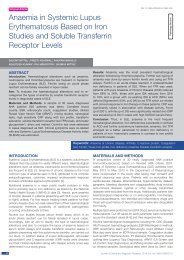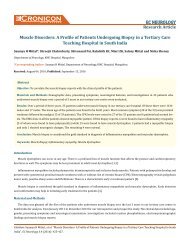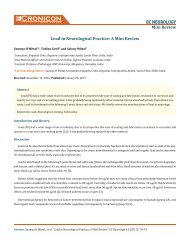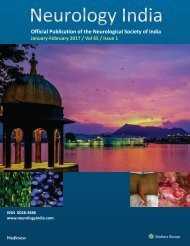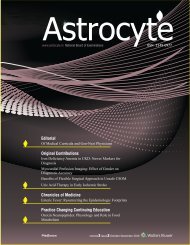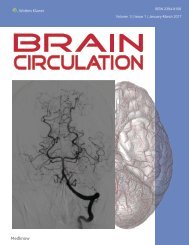Abnormal Levels of Consciousness and their Electroencephalogram Correlation- A Review
You also want an ePaper? Increase the reach of your titles
YUMPU automatically turns print PDFs into web optimized ePapers that Google loves.
Cronicon<br />
OPEN ACCESS<br />
EC NEUROLOGY<br />
<strong>Review</strong> Article<br />
<strong>Abnormal</strong> <strong>Levels</strong> <strong>of</strong> <strong>Consciousness</strong> <strong>and</strong> <strong>their</strong> <strong>Electroencephalogram</strong><br />
<strong>Correlation</strong>: A <strong>Review</strong><br />
Saumya H Mittal 1 *, Shruthi Salian 2 , Yashaswini Devadiga 2 , Nisha Shenoy 1 , Gaurang Gheewala 1 , Arvind Kulkarni 1 ,<br />
Bhautik Patel 1 , Geetha Ramesh 2 , Swathi HM 2 , Priya Bekal 3 , Sahana S 3 , Shivan<strong>and</strong>a Pai 4 , Z K Misri 5 <strong>and</strong> Rakshith KC 6<br />
1<br />
DNB Neurology, Registrar, Department <strong>of</strong> Neurology, KMC Hospital, Mangalore, India<br />
2<br />
EEG Technician students, Neurophysiology Lab, Department <strong>of</strong> Neurology, KMC Hospital, Mangalore, India<br />
3<br />
Technicians, Neurophysiology Lab, Department <strong>of</strong> Neurology, KMC Hospital, Mangalore, India<br />
4<br />
Assistant Pr<strong>of</strong>essor, Department <strong>of</strong> Neurology, KMC Hospital, Mangalore, India<br />
5<br />
Associate Pr<strong>of</strong>essor, Department <strong>of</strong> Neurology, KMC Hospital, Mangalore, India<br />
6<br />
Associate Pr<strong>of</strong>essor <strong>and</strong> Head, Department <strong>of</strong> Neurology, KMC Hospital, Mangalore, India<br />
*Corresponding Author: Saumya H Mittal, DNB Neurology, Registrar, Department <strong>of</strong> Neurology, KMC Hospital, Mangalore, India.<br />
Received: December 03, 2016; Published: December 13, 2016<br />
Abstract<br />
<strong>Consciousness</strong> is a state <strong>of</strong> awareness <strong>of</strong> self <strong>and</strong> the interaction with the surrounding environment <strong>and</strong> the components <strong>of</strong> the<br />
environment. The term also has other uses such as collective consciousness (set <strong>of</strong> shared beliefs, ideas <strong>and</strong> morality that unifies as<br />
a force within a society), specific consciousness (that gives a conscious state the particular phenomenal quality) <strong>and</strong> general consciousness<br />
(that makes a state conscious at all).<br />
<strong>Electroencephalogram</strong> records brain’s electrical activity via metal electrodes attached to skin on the head. The waves are transmitted<br />
to a recording device <strong>and</strong> the process routinely takes 30-90 minutes on an average. It is a grossly under utilised tool with<br />
prominent <strong>and</strong> <strong>of</strong>ten the only known use being in seizure disorders <strong>and</strong> epilepsy.<br />
The disorders <strong>of</strong> consciousness are acute <strong>and</strong> chronic. <strong>Electroencephalogram</strong> is known to be effective in detecting these disorders,<br />
monitoring them <strong>and</strong> prognosticating them. However, very few non-neurologists are aware <strong>of</strong> this use as a tool for disorders <strong>of</strong><br />
consciousness.<br />
Keywords: <strong>Consciousness</strong>; <strong>Electroencephalogram</strong>; Acute Disorders <strong>of</strong> <strong>Consciousness</strong>; Clouding <strong>of</strong> <strong>Consciousness</strong>; Delirium; Obtundation;<br />
Stupor; Locked in State; Coma; Chronic Disorders <strong>of</strong> <strong>Consciousness</strong>; Dementia; Hypersomnia; Abulia; Akinetic Mutism; Minimal Conscious<br />
State; Vegetative State Brain Death<br />
Introduction<br />
<strong>Electroencephalogram</strong> (EEG) is a valuable tool <strong>and</strong> is grossly underutilized. Most non-neurologists use it only for seizures <strong>and</strong> epilepsy.<br />
This is a very valuable tool in other spectrum <strong>of</strong> the diseases as well including abnormal levels <strong>of</strong> consciousness where EEG can not only<br />
provide a diagnosis, but may also help prognosticate cases <strong>and</strong> monitor therapy. We hereby discuss the EEG features <strong>of</strong> the various disorders<br />
<strong>of</strong> consciousness.<br />
Article Proper<br />
<strong>Consciousness</strong> is a state <strong>of</strong> awareness <strong>of</strong> self <strong>and</strong> the interaction with the surrounding environment <strong>and</strong> the components <strong>of</strong> the environment.<br />
The two major components <strong>of</strong> consciousness are content <strong>and</strong> arousal. The content includes all the functions that are maintained<br />
by cortical functions inclusive <strong>of</strong> cognition <strong>and</strong> affective response. There may be associated loss <strong>of</strong> recognition <strong>of</strong> the type <strong>of</strong> stimuli. Re-<br />
Citation: Saumya H Mittal., et al. “<strong>Abnormal</strong> <strong>Levels</strong> <strong>of</strong> <strong>Consciousness</strong> <strong>and</strong> <strong>their</strong> <strong>Electroencephalogram</strong> <strong>Correlation</strong>: A <strong>Review</strong>”. EC<br />
Neurology 4.1 (2016): 30-35.
<strong>Abnormal</strong> <strong>Levels</strong> <strong>of</strong> <strong>Consciousness</strong> <strong>and</strong> <strong>their</strong> <strong>Electroencephalogram</strong> <strong>Correlation</strong>: A <strong>Review</strong><br />
31<br />
duced level <strong>of</strong> consciousness may be due to reduction <strong>of</strong> the behavioural responses. It may occur due to abnormality <strong>of</strong> cortical function<br />
as well as specific brainstem injuries. The acute disorders <strong>of</strong> consciousness are clouding <strong>of</strong> consciousness, delirium, obtundation, stupor,<br />
locked in state <strong>and</strong> coma. The sub-acute or chronic forms <strong>of</strong> disorders <strong>of</strong> consciousness are dementia, hypersomnia, abulia, akinetic mutism,<br />
minimal conscious state, vegetative state <strong>and</strong> brain death [1].<br />
Clouding <strong>of</strong> consciousness or brain fog is an abnormal regulation <strong>of</strong> consciousness. Clouding <strong>of</strong> consciousness is a very mild form <strong>of</strong><br />
altered mental status in which the patient has inattention <strong>and</strong> reduced wakefulness. This is the mildest form <strong>of</strong> altered consciousness <strong>and</strong><br />
is usually seen with delirium being one <strong>of</strong> the features noted with delirium. There is minimally reduced wakefulness or awareness. There<br />
may be hyperexcitability <strong>and</strong> irritability. The orientation is affected, more commonly to time <strong>and</strong> place. The patients are inattentive <strong>and</strong><br />
have poor backward repetition. Cerebral oxygen consumption is usually reduced by at least 20% [1,2].<br />
<strong>Electroencephalogram</strong> (EEG) changes may be characteristic or may be associated to the associated abnormality <strong>and</strong> may provide confirmatory<br />
evidence in cases where establishing diagnosis is difficult on clinical basis. This is more so if a prior EEG is available because the<br />
first change observed is the slowing <strong>of</strong> the alpha rhythm wherein the slowed rhythm may still lie within normal range but is slow for the<br />
individual. Retrospective diagnosis may be made by repeating EEG once the patients has been stabilised. As the confusion <strong>and</strong> impairment<br />
<strong>of</strong> consciousness becomes more prominent, activity at lower frequency can be seen [3].<br />
Delirium is a disorder <strong>of</strong> consciousness with decreased ability to focus, sustain or shift attention. There is change in cognition or development<br />
<strong>of</strong> a perceptual disturbance not otherwise accounted for. The disturbance usually develops suddenly over a short period <strong>of</strong> time<br />
<strong>and</strong> there are fluctuations in the course <strong>of</strong> the day. The patients are disoriented to time, place <strong>and</strong> rarely to person. The delirium may be<br />
<strong>of</strong> three type-hyperactive delirium, hypoactive delirium <strong>and</strong> mixed delirium [4].<br />
In delirium, the EEG may show slowing or dropout <strong>of</strong> posterior dominant rhythm, generalized slow wave activity-theta wave or delta<br />
waves may be seen. The background activity is poorly organized. There may be loss <strong>of</strong> reaction to eye opening <strong>and</strong> closing. There is a<br />
reduced ratio <strong>of</strong> fast to slow b<strong>and</strong> power. There is reduced peak frequency <strong>of</strong> occipital leads. Eye closed activity <strong>of</strong> two electrodes yielding<br />
a frontoparietal derivation may help identify delirium <strong>and</strong> differentiate it from those without delirium. However, the specificity <strong>of</strong> EEG in<br />
delirium is circumspect [5].<br />
Obtundation is a state <strong>of</strong> sluggish responsiveness, with increased somnolence, <strong>and</strong> reduced interaction <strong>and</strong> interest in the environment.<br />
The correlation between severity <strong>of</strong> EEG <strong>and</strong> cognitive dysfunction is seen well in obtundation compared to other forms <strong>of</strong> dysfunction.<br />
This is especially true for subcortical dementia. A number <strong>of</strong> abnormal EEG patterns are seen <strong>and</strong> suggest the mechanism underlying<br />
obtundation. These include burst suppression pattern, alpha coma pattern, spindle coma pattern, triphasic waves <strong>and</strong> periodic lateralized<br />
epileptiform discharges. EEG changes usually seen in non-convulsive status epilepticus (periodic lateralized epileptiform discharges,<br />
bilateral independent periodic lateralized epileptiform discharges, generalized periodic epileptiform discharges) may also be seen [6].<br />
In stupor, the patient demonstrates behavioural unresponsiveness <strong>and</strong> deep sleep. They can be aroused by vigorous <strong>and</strong> continuous<br />
stimulation but the patient, even with maximum stimulation such as pain, bright light, <strong>and</strong> loud noise shows impaired response. A condition<br />
affecting the ascending reticular activation system is usually implicated in stupor. In stuporous patients, in addition to generalized<br />
slowing- delta <strong>and</strong> theta rhythm, the EEG also shows triphasic waves. The complex has two electronegative waves separated by an electronegative<br />
wave that has higher amplitude. The waves may sometimes resemble a myoclonic discharge. Bilateral independent periodic<br />
lateralized epileptiform discharges, generalized periodic epileptiform discharges may also be seen. Occasionally, epileptiform discharges<br />
have also been noted [3,7].<br />
Coma is a state <strong>of</strong> unresponsiveness where the patient’s eyes are closed <strong>and</strong> the examiner fails to elicit arousal or response to even<br />
vigorous stimulation. There may be grimacing or withdrawal response. No defensive or localising movement occurs [8].<br />
Citation: Saumya H Mittal., et al. “<strong>Abnormal</strong> <strong>Levels</strong> <strong>of</strong> <strong>Consciousness</strong> <strong>and</strong> <strong>their</strong> <strong>Electroencephalogram</strong> <strong>Correlation</strong>: A <strong>Review</strong>”. EC<br />
Neurology 4.1 (2016): 30-35.
<strong>Abnormal</strong> <strong>Levels</strong> <strong>of</strong> <strong>Consciousness</strong> <strong>and</strong> <strong>their</strong> <strong>Electroencephalogram</strong> <strong>Correlation</strong>: A <strong>Review</strong><br />
EEG is a supplemental investigation in coma. It allows documentation <strong>of</strong> thalamocortical dysfunction. EEGs may help prognosticate<br />
the patient especially when a complete generalized suppression is noted <strong>of</strong> less than 10 micro volts e.g. in cases <strong>of</strong> cardiac arrest. Other<br />
forms <strong>of</strong> activities that may be seen include periodic complexes, marked suppression, epileptiform activity, burst suppression, alpha theta<br />
coma patterns etc. While a single EEG may help with the diagnosis, serial EEG can monitor unstable patients <strong>and</strong> can reflect on response<br />
to therapy in treatable causes <strong>of</strong> coma. Testing <strong>of</strong> reactivity <strong>and</strong> multiple variables may be <strong>of</strong> role in this role. EEG may show beta coma<br />
intermingled with alpha or delta activity. Alpha coma may be seen. This may be diffuse or monomorphic <strong>and</strong> posterior. Theta coma usually<br />
predicts a poor prognosis. Diffuse, focal, unilateral or anterior predominant high voltage delta activity is seen most frequently in<br />
metabolic encephalopathy. In others, low voltage delta coma may be seen. Spindle coma may be seen with traumatic brain injury. Burst<br />
suppression pattern with or without interruption may suggest intoxication. Finally, electro-cerebral inactivity may be said to be present<br />
if there is no spontaneous neuronal activity detectable [8].<br />
Locked in syndrome is a condition where there is a complete paralysis <strong>of</strong> all voluntary muscles except for ocular movements while<br />
the patient is aware <strong>and</strong> conscious, <strong>and</strong> results usually from brainstem lesions. EEG may be normal or it can show alpha coma pattern<br />
with or without unreactive alpha rhythm to multimodal stimuli. In another study, EEGs showed a reactive alpha rhythm most <strong>of</strong> the time<br />
or a theta rhythm that suggests consciousness. Minor focal or bilateral disturbances may be noted in theta or fast delta range. In a truly<br />
comatose patient, alpha rhythm, if present, is unresponsive to stimulus. Relatively normal EEG with reactivity in a patient who otherwise<br />
appears unconscious may suggest the possibility <strong>of</strong> Locked in Syndrome. EEG may also show abnormal desynchronous, poorly organized<br />
background activity. So, EEG may provide a simple, non-invasive quick test <strong>of</strong> diagnosing Locked in State at bedside [9-11].<br />
Hypersomnia is a state <strong>of</strong> excessive but normal appearing sleep. The person awakens readily when stimulated. The duration <strong>of</strong> the<br />
‘awake’ period may be brief. Some suggest that the symptom should be present for at least 3 months before being significant. But this may<br />
not be the case in acute settings. In a truly hypersomnia patient, sleep is normal <strong>and</strong> cognition is intact while awake. In pathological state,<br />
the patient has clouded consciousnesses when awake. Many acute <strong>and</strong> chronic conditions are associated with hypersomnia as a symptom.<br />
Hypothalamic dysfunction is implicated with the condition [12,13].<br />
The EEG may be normal or may show slight slowing, with slow activity record intermittently especially theta activity on ‘awake’ EEG.<br />
Epileptiform discharges have been seen in some cases. Minimum weighted average instantaneous frequency might be an intrinsic character.<br />
The EEG changes specific to the cause <strong>of</strong> hypersomnia may be seen [14-16].<br />
Abulia is a syndrome <strong>of</strong> diminished motivation. In abulia, the patient looks away, stares emptily, <strong>and</strong> seems to be in a daze. However,<br />
there may be sudden expression <strong>of</strong> concern on subjects with a complete grammatical language <strong>and</strong> animation. Patient refuses to cooperate<br />
for formal testing despite an intact ability to do so. There is reduced dopaminergic activity in bilateral centromedial core <strong>of</strong> the brain.<br />
Cases are also known to occur due to damage to basal ganglia, capsular genu, caudate nucleus <strong>and</strong> anterior cingulated circuit. Abulia<br />
shows bifrontal or generalized slowing with lack <strong>of</strong> desynchronization following any external stimuli. Slowing may be focal or unilateral.<br />
Slow alpha activity may be seen in some [17,18].<br />
Minimally conscious state is a disorder <strong>of</strong> severely impaired consciousness where there is a partial minimal preservation <strong>of</strong> the awareness.<br />
They demonstrate behavioural evidence <strong>of</strong> self <strong>and</strong> perform some activities that suggest this awareness <strong>of</strong> self <strong>and</strong> the environment<br />
such as following objects <strong>and</strong> reacting to questions <strong>and</strong> comm<strong>and</strong>s even if appropriate. There is usually continuous but incomplete improvement.<br />
Others have a good recovery sufficient for independent activities. It may be an intermediate state that arises during recovery<br />
from coma or alternatively while worsening <strong>of</strong> the neurological status [19].<br />
The type <strong>of</strong> EEG abnormality observed may vary with the location <strong>of</strong> the lesion. EEG shows diffuse or focal slowing- theta <strong>and</strong> delta<br />
waves. There is disorganization in the more severely injured hemisphere with decreased reactivity <strong>of</strong> posterior dominant rhythm. While<br />
changes are ipsilesional, bilateral changes may be seen. Slowing is most apparent in the electrodes closest to the lesion. EEG may suggest<br />
cortical dysfunction. They may identify occult seizure activities. Asleep EEG shows continuous polymorphic slowing especially near the<br />
lesion. Sleep spindles are attenuated [20].<br />
32<br />
Citation: Saumya H Mittal., et al. “<strong>Abnormal</strong> <strong>Levels</strong> <strong>of</strong> <strong>Consciousness</strong> <strong>and</strong> <strong>their</strong> <strong>Electroencephalogram</strong> <strong>Correlation</strong>: A <strong>Review</strong>”. EC<br />
Neurology 4.1 (2016): 30-35.
<strong>Abnormal</strong> <strong>Levels</strong> <strong>of</strong> <strong>Consciousness</strong> <strong>and</strong> <strong>their</strong> <strong>Electroencephalogram</strong> <strong>Correlation</strong>: A <strong>Review</strong><br />
Vegetative state is recovery <strong>of</strong> the arousal state <strong>and</strong> its cycling. It is usually identified initially by periods <strong>of</strong> eye opening in a previously<br />
unresponsive patient. The patients show no signs <strong>of</strong> awareness <strong>of</strong> the environment or self. However, they maintain <strong>their</strong> cardiopulmonary<br />
functions <strong>and</strong> autonomic functions because brainstem is usually preserved. A term persistent vegetative state may be used if the vegetative<br />
state lasts for at least 30 days. Usually it switches to coma by 10 to 30 days. A term permanent vegetative state may be used if the<br />
vegetative state lasts from three months to a year in non-traumatic <strong>and</strong> traumatic conditions respectively [19].<br />
EEG may be normal. A multitude <strong>of</strong> ‘awake’ EEG patterns is known. There is a generalized slowing in theta <strong>and</strong> delta rhythms that may<br />
be continuous or intermittent. The background is attenuated <strong>and</strong> EEG is isoelectric. Periodic lateralized epileptiform discharges <strong>and</strong> triphasic<br />
waves are also seen. Same patient may show more than one type <strong>of</strong> waveforms at different times <strong>of</strong> testing. Epileptiform discharges<br />
may be seen such as focal sharp waves. Alpha-theta coma <strong>and</strong> spindle coma may be seen. A correlation may be seen between the clinical<br />
outcome <strong>and</strong> the initial EEG grade. Normal diurnal <strong>and</strong> nocturnal pattern may be preserved. EEG reactivity may be affected. Many sleep<br />
changes are not seen such as r<strong>and</strong>om eye movements, sleep spindles <strong>and</strong> vertex waves. Diminution or absence <strong>of</strong> EEG fluctuation during<br />
sleep-wake cycle serves as an indicator <strong>of</strong> brainstem dysfunction <strong>and</strong> its severity. EEG coherence serves as a better prognostic indicator for<br />
recovery after brain injury. High amplitude theta frequencies in these patients may be significant for favourable outcome [20,21].<br />
First described by Cairns., et al. in 1941, akinetic mutism patients are silent <strong>and</strong> appear alert though immobile. They may have sleep<br />
wake cycles but mental activity is almost absent. Spontaneous motor activity is absent. Besides, motor activity, spontaneity <strong>and</strong> initiation<br />
<strong>of</strong> actions ideas, speech <strong>and</strong> emotion are completely or nearly completely lost. Attention may be passively drawn to environmental<br />
stimulus. Lesions may be in basal forebrain or hypothalamus. These patients are not paralyzed but do not have the will to move. They may<br />
occasionally whisper monosyllables. It is <strong>of</strong> 2 types- frontal <strong>and</strong> mesencephalic types [19].<br />
EEG shows periodic sharp wave complexes. These usually occur after onset <strong>of</strong> myoclonus, but may occur prior to the myoclonus as well.<br />
Frontal intermittent rhythmic delta activity, frontal intermittent rhythmic triphasic slow waves are other waveforms that may be seen.<br />
These latter may herald the onset <strong>of</strong> periodic sharp wave complexes [22].<br />
Brain death is irreversible loss <strong>of</strong> functions <strong>of</strong> the entire brain such that the body cannot maintain the respiratory <strong>and</strong> cardiovascular<br />
homeostasis. It eventually results into loss <strong>of</strong> systemic circulation. The cerebral hemispheres function depends on brainstem <strong>and</strong> therefore<br />
cerebral hemisphere functions cannot be tested accurately when brainstem is not functioning. Brainstem death is therefore identified<br />
as irreversible loss <strong>of</strong> capacity for consciousness, with irreversible loss <strong>of</strong> capacity to breathe. EEG in brain death demonstrates electro<br />
cortical silence. EEG is considered an optional test <strong>and</strong> therefore most consider that diagnosis <strong>of</strong> irreversible death <strong>of</strong> brainstem is sufficient<br />
to infer death, not needing the instrumentation [19,23-25].<br />
Dementia is enduring <strong>and</strong> progressive decline in mental process due to organic processes. Arousal may not be affected. DSM-IV defines<br />
dementia as follows: A. The development <strong>of</strong> multiple cognitive defects manifested by both: (1) Memory impairment (impaired ability to<br />
learn new information or to recall previously learned information); (2) One (or more) <strong>of</strong> the following cognitive disturbances: aphasia<br />
(language disturbance), apraxia (impaired ability to carry out motor activities despite intact motor function), agnosia (failure to recognize<br />
or identify objects despite intact sensory function), disturbance in executive function (i.e., planning, organization, sequencing, abstracting).<br />
Patients are usually awake <strong>and</strong> alert. There are many types <strong>of</strong> dementia. Most common forms <strong>of</strong> dementia are Alzheimer’s disease,<br />
vascular dementia, Lewy body dementia, frontotemporal dementia, normal pressure hydrocephalus, Parkinson’s disease, Creutzfeldt Jakob<br />
disease etc. Dementia has three stages- early, middle <strong>and</strong> late [3].<br />
EEG can diagnose the common dementias like Alzheimer’s disease <strong>and</strong> vascular dementia. The former shows slow posterior rhythm<br />
frequency. There is increased diffuse slow frequency. And there is reduction <strong>of</strong> alpha <strong>and</strong> beta activities. In vascular dementia, occipital alpha<br />
rhythm is present while theta power increases. Delta power increase in both Alzheimer’s disease <strong>and</strong> vascular dementia. Power ratio<br />
<strong>of</strong> alpha 3/alpha 2 is an early prognostic marker <strong>of</strong> Minimal Cognitive Impairment. Creutzfeldt Jacob disease shows bilateral sharp waves.<br />
33<br />
Citation: Saumya H Mittal., et al. “<strong>Abnormal</strong> <strong>Levels</strong> <strong>of</strong> <strong>Consciousness</strong> <strong>and</strong> <strong>their</strong> <strong>Electroencephalogram</strong> <strong>Correlation</strong>: A <strong>Review</strong>”. EC<br />
Neurology 4.1 (2016): 30-35.
<strong>Abnormal</strong> <strong>Levels</strong> <strong>of</strong> <strong>Consciousness</strong> <strong>and</strong> <strong>their</strong> <strong>Electroencephalogram</strong> <strong>Correlation</strong>: A <strong>Review</strong><br />
There may be sharp <strong>and</strong> slow waves. Background, normal initially, shows delta <strong>and</strong> theta waves as disease progresses. Alcohol dementias<br />
<strong>of</strong>ten show normal EEG patterns. Specific changes may vary with the type <strong>of</strong> dementia. Newer techniques like coherence analysis, evoked<br />
potentials, <strong>and</strong> event related potentials are bound to add to sensitivity <strong>of</strong> the EEG [3,26].<br />
Conclusion<br />
EEG is a valuable tool in cases <strong>of</strong> abnormal levels <strong>of</strong> consciousness. And every EEG should be compared with prior EEGs to make out<br />
subtle changes. In expert h<strong>and</strong>s, it is a useful tool.<br />
Bibliography<br />
1. Posner JB <strong>and</strong> Plum F. “The toxic effects <strong>of</strong> carbon dioxide <strong>and</strong> acetazolamide in hepatic encephalopathy”. Journal <strong>of</strong> Clinical Investigation<br />
39.8 (1960): 1246-1258.<br />
2. Shimojyo S., et al. “Cerebral blood flow <strong>and</strong> metabolism in the Wernicke-Korsak<strong>of</strong>f syndrome”. Journal <strong>of</strong> Clinical Investigation 46.5<br />
(1967): 849-854.<br />
3. Kiloh l G. “The electroencephalogram in psychiatry”. Postgraduate Medical Journal 39 (1963): 34-47.<br />
4. Tamara G Fong., et al. “The interface between delirium <strong>and</strong> dementia in elderly adults”. Lancet Neurology 14.8 (2015): 823-832.<br />
5. Van der Kooi AW., et al. “Delirium detection using EEG: what <strong>and</strong> how to measure”. Chest 147.1 (2015): 94-101.<br />
6. Brenner RP. “The interpretation <strong>of</strong> the EEG in stupor <strong>and</strong> coma”. Neurologist 11.5 (2005): 271-284.<br />
7. Andrade Chittaranjan <strong>and</strong> Kumar Sanjay N. “Manic stupor”. Indian Journal <strong>of</strong> Psychiatry 43.3 (2001): 285-286.<br />
8. Raoul Sutter <strong>and</strong> Peter W Kaplan. “Electroencephalographic Patterns in Coma: When Things Slow down”. Epileptologie 29 (2012):<br />
201-209.<br />
9. Jacome De <strong>and</strong> Morilla-Pastor D. “Unreactive eeg: pattern in locked-in syndrome”. Clinical Electroencephalography 21.1 (1990): 31-<br />
36.<br />
10. C H Hawkes <strong>and</strong> l Bryan-Smyth. “The electroencephalogram in the “locked‐in” syndrome”. Neurology 24.11 (1974): 1015-1018.<br />
11. Patterson J R <strong>and</strong> Grabois M. “Locked-in syndrome: a review <strong>of</strong> 139 cases”. Stroke 17.4 (1986): 758-764.<br />
12. Billiard M <strong>and</strong> Dauvilliers Y. “Idiopathic hypersomnia”. Sleep Medicine <strong>Review</strong>s 5.5 (2001): 349-358.<br />
13. Yves Dauvilliers <strong>and</strong> Alain Buguet. “Hypersomnia”. Dialogues in Clinical Neuroscience 7.4 (2005): 347-356.<br />
14. Jocelyn Y Cheng., et al. “Nocturnal Frontal Lobe Epilepsy Presenting as Excessive Daytime Sleepiness”. Journal <strong>of</strong> Family Medicine <strong>and</strong><br />
Primary Care 2.1 (2013): 101-103.<br />
15. Tarik Al-ani., et al. “On-linear EEG Analysis <strong>of</strong> Idiopathic Hypersomnia”. Imaging <strong>and</strong> Signal Processing 6134 (2010): 297-306.<br />
16. Ganji Srinivas S., et al. “Hypersomnia Associated with a Focal Pontine Lesion”. Clinical EEG <strong>and</strong> Neuroscience 27.1 (1996): 52-56.<br />
17. SM Hastak., et al. “Abulia: No Will, No Way”. Journal <strong>of</strong> the Association <strong>of</strong> Physicians <strong>of</strong> India 53 (2005): 814-818.<br />
34<br />
Citation: Saumya H Mittal., et al. “<strong>Abnormal</strong> <strong>Levels</strong> <strong>of</strong> <strong>Consciousness</strong> <strong>and</strong> <strong>their</strong> <strong>Electroencephalogram</strong> <strong>Correlation</strong>: A <strong>Review</strong>”. EC<br />
Neurology 4.1 (2016): 30-35.
<strong>Abnormal</strong> <strong>Levels</strong> <strong>of</strong> <strong>Consciousness</strong> <strong>and</strong> <strong>their</strong> <strong>Electroencephalogram</strong> <strong>Correlation</strong>: A <strong>Review</strong><br />
18. H Forstl <strong>and</strong> B Sahakian. “A psychiatric presentation <strong>of</strong> abulia-three cases <strong>of</strong> left frontal lobe ischaemia <strong>and</strong> atrophy”. Journal <strong>of</strong> the<br />
Royal Society <strong>of</strong> Medicine 84 (1991): 89-91.<br />
19. S Laureys., et al. “Cerebral Function in Coma, Vegetative State, Minimally Conscious State, Locked-in Syndrome, <strong>and</strong> Brain Death”.<br />
Yearbook <strong>of</strong> Intensive Care <strong>and</strong> Emergency Medicine, J-L Vincent (Ed.), Springer, Berlin (2001): 386-396.<br />
20. Erik J Kobylarz <strong>and</strong> Nicholas D Schiff. “Neurophysiological correlates <strong>of</strong> persistent vegetative <strong>and</strong> minimally conscious states”. Neuropsychological<br />
Rehabilitation 15.3-4 (2005): 323-332.<br />
21. Tinatin Kherkheulidze., et al. “EEG patterns as predictors <strong>of</strong> outcome in patients with vegetative state <strong>and</strong> minimally conscious state”.<br />
Neurology 84.14 (2015): P4.171.<br />
22. Ingvar DH. “EEG <strong>and</strong> cerebral circulation in the apallic syndrome <strong>and</strong> akinetic mutism”. Electroencephalography <strong>and</strong> Clinical Neurophysiology<br />
30.3 (1971): 272-273.<br />
23. Kwiccsinki H., et al. “On the determination <strong>of</strong> brain death”. Neurologia i Neurochirurgia Polska 28 (1994):175-186.<br />
24. Belluci G <strong>and</strong> Rosi R. “Determination <strong>of</strong> brain death in Italy”. Minerva Anestesiologica 60.10 (1994): 619-623.<br />
25. Link J <strong>and</strong> Shaefer M. “Concepts <strong>and</strong> diagnosis <strong>of</strong> brain death”. Forensic Science International 19 (1994): 195-203.<br />
26. Noor Kamal Al-Qazzaz., et al. “Role <strong>of</strong> EEG as Biomarker in the Early Detection <strong>and</strong> Classification <strong>of</strong> Dementia”. The Scientific World<br />
Journal (2014).<br />
35<br />
Volume 4 Issue 1 December 2016<br />
© All rights reserved by Saumya H Mittal., et al.<br />
Citation: Saumya H Mittal., et al. “<strong>Abnormal</strong> <strong>Levels</strong> <strong>of</strong> <strong>Consciousness</strong> <strong>and</strong> <strong>their</strong> <strong>Electroencephalogram</strong> <strong>Correlation</strong>: A <strong>Review</strong>”. EC<br />
Neurology 4.1 (2016): 30-35.


